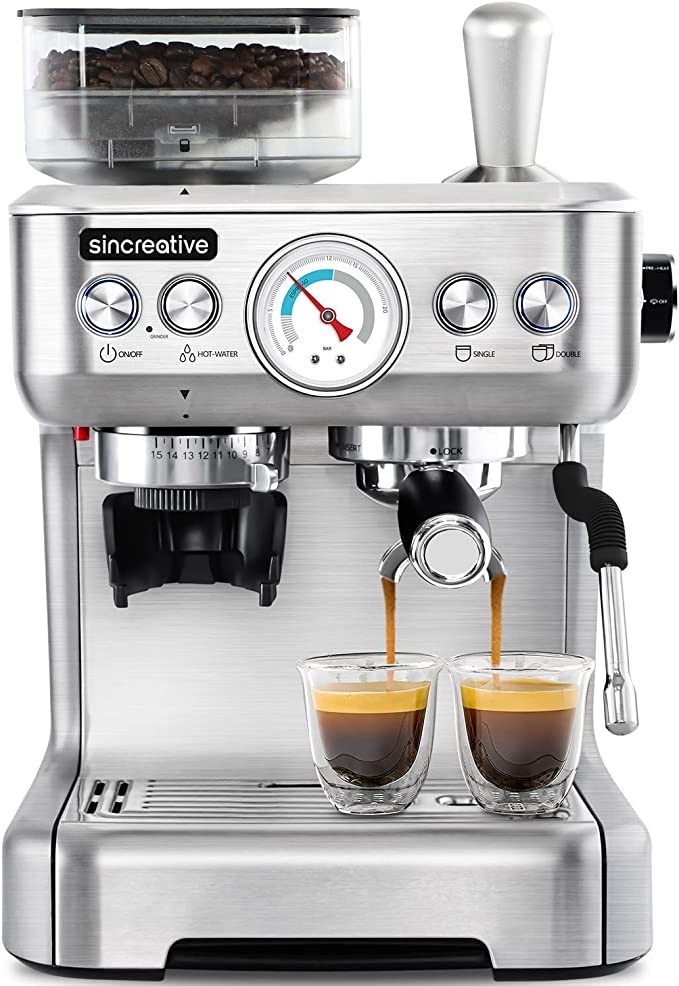Bestpresso Single Serve Coffee Maker | The Science of 19 Bar Espresso at Home
Update on March 31, 2025, 7:03 a.m.
The ritual is familiar to millions: the rich aroma unfurling, the sight of a dark, intense liquid crowned with a velvety layer of reddish-brown foam, the invigorating first sip. Espresso. It’s a small cup holding a universe of complex flavors and sensations. For decades, achieving this perfection at home felt like the exclusive domain of skilled baristas with elaborate, expensive machinery. The quest for convenience without compromising quality led to a revolution: the single-serve capsule system. These compact powerhouses promise near-instant espresso gratification. But how do they actually work? What intricate dance of physics and chemistry happens inside that small appliance when you press a button?
Let’s embark on a journey to demystify the technology, peeling back the layers of science behind these popular brewers. We’ll use the Bestpresso Single Serve Coffee Maker, specifically designed for compatibility with the widely available Nespresso® Original line capsules, as our lens. This isn’t about selling a machine; it’s about understanding the fascinating engineering and scientific principles that allow such a device to transform a simple capsule and water into a satisfying cup of espresso, right on your kitchen counter.

Decoding Espresso: More Than Just Strong Coffee
Before we dive into the hardware, let’s clarify what constitutes “espresso.” It’s not merely strong coffee; it’s a distinct brewing method defined by forcing a small amount of hot water (typically around 90-96°C or 195-205°F) through a tightly packed bed of finely ground coffee under significant pressure (at least 9 bars) for a short period (usually 20-30 seconds for a standard shot). This intense, rapid extraction process yields a concentrated beverage with a unique balance of acidity, sweetness, and bitterness, characterized by its syrupy body and, crucially, its crema.
Ah, the crema. That persistent, finely textured foam is more than just pretty; it’s an emulsion of coffee oils, water, microscopic coffee solids, and trapped carbon dioxide (CO2 – a byproduct of the roasting process, gradually released from fresh beans). Its presence indicates freshness (CO2 depletes over time) and, generally, a properly executed extraction under sufficient pressure. It contributes significantly to the mouthfeel and aromatic complexity of the espresso. Achieving this requires mastering the two fundamental pillars of espresso extraction: pressure and temperature.

The Force Within: Understanding Pressure (19 Bars of Power)
Let’s talk about pressure, measured in bars. One bar is roughly equivalent to the atmospheric pressure at sea level. Why is high pressure so critical for espresso? Imagine trying to push water through a dense puck of very fine coffee grounds quickly. Gravity alone won’t cut it. You need force.
High pressure, typically starting around 9 bars, performs several vital tasks simultaneously:
- Compaction & Resistance: It initially helps compact the coffee grounds slightly, creating resistance that the water must overcome.
- Rapid Saturation & Extraction: It forces the hot water to penetrate the coffee bed evenly and rapidly, dissolving soluble flavor compounds (sugars, acids, melanoidins) far more efficiently than lower-pressure methods like drip coffee.
- Emulsification of Oils: Crucially, the intense pressure emulsifies the coffee bean’s natural oils with the water. These oils carry many volatile aromatic compounds and contribute significantly to espresso’s characteristic viscosity and rich mouthfeel.
- Crema Formation: The high pressure helps dissolve CO2 gas present in the coffee grounds into the water. As the espresso exits the machine and returns to normal atmospheric pressure, this dissolved CO2 rapidly comes out of solution, forming the tiny, stable bubbles that constitute the crema, trapping those emulsified oils within its structure.
The Bestpresso machine boasts a 19 Bar high-pressure pump, often highlighted with the descriptor “Italian Pump”. While the minimum requirement for espresso is generally accepted as 9 bars, the Nespresso system itself is designed around higher pressures, typically operating in the 15-19 bar range. Having a 19-bar capability ensures the pump has more than enough power to consistently force water through the resistance of the capsule’s coffee bed and perforation system, achieving the necessary conditions for full extraction and crema formation. It’s like having a car engine with ample horsepower – it doesn’t always use its maximum, but the capability is there to handle demanding situations smoothly.
What about the “Italian Pump” claim? Italy is the birthplace of espresso, and Italian manufacturers (like ULKA, CEME) are renowned for producing high-quality pumps used in many coffee machines worldwide. While the claim on its own doesn’t guarantee specific performance metrics without further details, it often implies adherence to certain design standards, manufacturing experience, and potentially greater durability associated with the Italian espresso machine tradition.
It’s worth noting that the heart of most home capsule machines, including likely this one, is a vibrating electromagnetic pump. These pumps work by rapidly oscillating a piston or diaphragm using an electromagnet. They are compact, relatively inexpensive, and capable of generating the high pressures needed. However, this rapid vibration is also the primary source of the characteristic buzzing or humming sound these machines make during operation – a normal physical consequence of this powerful, compact pump technology at work.
Harnessing Heat: The Thermodynamics of a Quick Brew
Pressure alone cannot conjure espresso; it needs a partner: precisely controlled temperature. The water must be hot enough to efficiently dissolve the desired flavor compounds but not so hot that it scorches the delicate grounds, leading to bitter, burnt tastes. The ideal range sits between 90-96°C (195-205°F). Water cooler than this tends to under-extract, resulting in sour, weak coffee.
How does the Bestpresso machine achieve this target temperature, and do so in a claimed 25-30 seconds? The answer almost certainly lies in a Thermoblock heating system. Unlike traditional boiler machines that heat and hold a larger volume of water, a thermoblock is essentially a compact metal block (often aluminum or stainless steel) with a narrow channel or coil running through it. High-power electrical heating elements are attached directly to the block.
When you initiate brewing, the pump pushes cold water from the reservoir through this heated channel. The large surface area and high power (indicated by the machine’s 1400-watt rating) allow for extremely rapid heat transfer – think of it like flash-heating the water just as it’s needed. This on-demand heating is why thermoblock machines boast such impressive start-up times. They don’t need to preheat a large mass of water. Imagine a sprinter taking off instantly versus a marathon runner needing time to reach full speed.
The advantage is speed and energy efficiency (only heating water when needed). The potential challenge for thermoblock systems, especially simpler ones, can be maintaining perfectly stable temperature throughout the entire shot, as flow rate and incoming water temperature can cause minor fluctuations. More advanced machines use sophisticated controllers (like PID controllers) to manage this, but even basic thermoblocks in capsule machines are designed to operate consistently within the acceptable espresso temperature range for the short duration of a capsule brew.
It’s also important to briefly consider the water itself. Water chemistry, particularly its mineral content (hardness), significantly impacts coffee flavor. Very soft water can lead to flat taste, while very hard water can mute acidity and, more practically, lead to limescale buildup within the machine’s heating element and pathways over time, potentially affecting performance and longevity. Using filtered water is often a good practice for both taste and machine health.

Consistency by Design: Programmable Shots & Capsule Precision
One of the biggest appeals of capsule systems is their consistency. Unlike manual espresso preparation, which involves variables like grind size, tamping pressure, and dosing, the capsule provides a pre-portioned, pre-ground, and pre-tamped dose in a sealed environment. The machine then controls the water volume and temperature. The Bestpresso machine enhances this consistency with programmable buttons for Espresso and Lungo shots.
What’s the difference? * Espresso: The classic short shot (Bestpresso specifies approx. 1.3 oz / 40 ml). It aims for a concentrated extraction, balancing acidity, sweetness, and bitterness within a short contact time. * Lungo: Meaning “long” in Italian, this uses significantly more water (Bestpresso specifies approx. 3.75 oz / 110 ml) pushed through the same amount of coffee. This extended contact time extracts different compounds, often resulting in a milder, less intense, slightly more bitter, and larger volume drink. It’s not just a watered-down espresso; the extraction dynamics are different.
The programmability allows you to set your preferred volume for each type of shot once, and the machine will dispense that exact amount every time you press the corresponding button. This takes user error out of the equation, ensuring your morning espresso or afternoon lungo is just the way you like it, day after day.
The Nespresso® Original capsule itself is a marvel of miniature engineering. Typically made of aluminum (which provides an excellent barrier against oxygen, light, and moisture, preserving freshness), it contains a precise dose of ground coffee. When inserted into the machine, sharp blades pierce the capsule foil at the front and patterned plates puncture the base. Hot water is then forced under pressure into the capsule, ideally flowing evenly through the coffee grounds, and exits through the pierced base into your cup. The machine’s compatibility with this system opens up a vast universe of coffee origins, roasts, and flavors from Nespresso and numerous other compatible capsule producers.
Living with the Machine: Ergonomics, Convenience, and Safety
Beyond the core brewing technology, thoughtful design makes a machine practical for daily use. The Bestpresso highlights several such features:
- Compact Footprint: At only 5 inches wide, this machine is genuinely space-saving, fitting comfortably into smaller kitchens, dorm rooms, or office nooks where counter real estate is precious.
- Effortless Workflow: After brewing, lifting the lever automatically ejects the used capsule into an internal container (holding several spent pods), keeping your counter clean. This simple mechanical action adds significantly to the convenience.
- Easy Cleaning: Hygiene is crucial. The water tank (0.8 Liters / 27 oz capacity), the drip tray, and the used capsule container are all easily removable. The manufacturer states these parts are dishwasher safe, simplifying cleanup considerably. Regular cleaning prevents coffee oil buildup and potential mold growth, ensuring better taste and hygiene. Think of it as the coffee machine equivalent of a self-cleaning cycle’s convenience, albeit manual.
- Thoughtful Touches: The folding cup tray accommodates taller mugs or glasses, useful for lungos or adding milk for cappuccinos or lattes (requires a separate milk frother).
- Smart & Safe: The automatic shut-off feature, defaulting to 9 minutes but reportedly extendable to 30, provides both energy savings and peace of mind, preventing the machine from staying on indefinitely if forgotten. Furthermore, the ETL Certification indicates the product has been independently tested and meets widely accepted North American safety standards for electrical appliances.
The Bigger Picture: Context, Considerations, and Coffee Choices
Single-serve capsule machines like the Bestpresso represent a specific point on the coffee-making spectrum. They emerged as a response to a growing desire for speed, convenience, and consistency, effectively democratizing access to espresso-style coffee at home. They excel at delivering a good, reliable shot with minimal effort or learning curve.
However, it’s essential to acknowledge the inherent trade-offs. The convenience comes at the cost of limited customization compared to semi-automatic or manual machines where users control grind, dose, tamp, temperature, and pressure profiles. You are reliant on the capsule ecosystem, which, while vast for Nespresso Original, does generate waste. The environmental impact of capsules (especially aluminum and plastic ones) is a significant ongoing discussion, although recycling programs and reusable capsule options exist.
The operational noise from the vibrating pump, as mentioned, is a physical characteristic of this technology class. And ultimately, the quality in the cup is heavily dependent not just on the machine’s ability to provide the right conditions (pressure, temperature, water volume), but critically on the quality and freshness of the coffee within the capsule itself. A great machine cannot salvage stale or poorly sourced coffee.
Finally, the presence of a 1-Year Warranty provides a level of consumer protection and indicates the manufacturer’s confidence in the product’s reliability for at least that period.
Conclusion: The Science in Your Sip
The Bestpresso Single Serve Coffee Maker, like its Nespresso-compatible peers, is more than just a button-press appliance. It’s a compact distillation of decades of espresso science and engineering. Within its small frame resides the power to generate immense pressure, the precision to heat water in seconds to a specific temperature window, and the programmed logic to deliver consistent volumes, all orchestrated to perform the complex ballet of espresso extraction.
Understanding the roles of the 19-bar pump, the thermoblock heater, the programmable controls, and the capsule system itself allows us to appreciate the technology not just for its convenience, but for the clever application of scientific principles. It empowers us to look beyond the surface and understand how that satisfying cup comes to be. Whether you’re a seasoned coffee aficionado or just beginning your journey, appreciating the science in your sip can only enhance the daily ritual we call coffee.







































